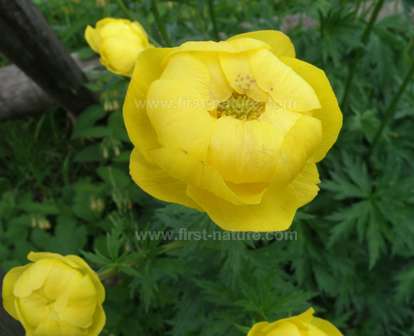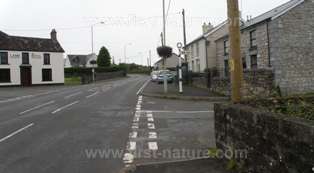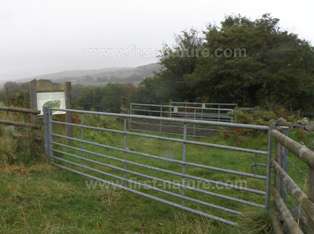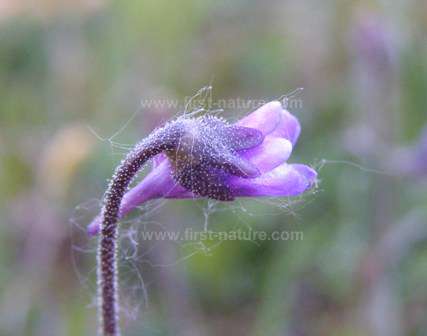Cwm Cadlan National Nature Reserve, Nr. Hirwaun, Rhondda Cynon Taf
Designations: part of the Cwm Cadlan SSSI and SAC
Below: The beautiful Globeflower (Trollius europaeus) grows in damp spots at Cwm Cadlan.

The marshy grassland found at Cwm Cadlan is unusual. There, lime-rich spring water flows through the reserve, creating alkaline habitats that support special chalk-loving plants, which can be seen alongside other species that are more typical of the acid soils that occur in most of this part of Wales. The lovely Globeflower (Trollius europeaus) grows in Cwm Cadlan, where it is at the most southerly limit of its UK distribution.
Considerable restoration work has been undertaken at Cwm Cadlan in recent years to undo the detrimental effects of historic land drainage that was carried out for agricultural purposes. This restoration work also helps to offset the damage to plants and reduction in wildlife populations that can occur the during long spells of weather dry that seem to have become more frequent of late.
Cwm Cadlan NNR is managed by Natural Resources Wales (NRW).
Directions
Grid Ref: SN952095
From the M4 Junction 32 at Cardiff take the A470 northwards to Merthyr Tydfil and continue along the same road towards Brecon. Cwm Cadlan is signed to the left of the A470 some 3km north of Merthyr Tidfil, where you turn left on to a small unmarked road in the direction of Penderyn.
Alternatively you can drive from Hirwaun on the A4059 towards Brecon and turn right on to the unmarked road just north of Penderyn and opposite the Lamb Inn - see below. This road is also signed to Cwm Cadlan.
Below: The sign to Cwm Cadlan from the A4059 at Penderyn

Access:
Open all year round, there is no formal parking area for the NNR but there is room for approximately four cars on a grassy bank close to the entrance of the Reserve. A track runs across the Reserve, but be aware that although it is relatively level it can be tricky in wet weather. There are one or two steeper sections on the track, and so good walking shoes are a necessity. There are also a number of gates along the track and a wooden bridge over the stream.
Access to some parts of Cwm Cadlan NNR are restricted in order to protect the sensitive plantlife.
Below: The entrance to Cwm Cadlan NNR

Facilities
There is an information board at the entrance of the site, but there are no other facilities. There are pubs, shops, cafés and public toilets in Penderyn, which is about 1.5km from the Reserve. Penderyn is also the home of Welsh Whisky, and there is a Visitor Centre with facilities in the village.
Description of Site
Cwm Cadlan lies in the valley of Nant Cadlan, which lies on the southern edge of the Brecon Beacons National Park. The nature reserve is underpinned by carboniferous limestone, and at least half of its area consists of bog, marsh and alkaline fen. As a result the NNR supports outstanding colonies of specialist plants in a number of specific habitats. In the alkaline fens the sedges include Tawny Sedge (Carex hostiana) and Flea Sedge (Carex pulicaris). Other plants that thrive in these alkaline conditions are Bogbean (Menyanthes trifoliata), which produces spears of white frothy flowers as early as March, Marsh Lousewort (Pedicularis palustris), which is semi-parasitic and Common Butterwort (Pinguicula vulgaris), which is insectivorous and gets some of its nutrients by trapping the tiny insects that also live in such places. Liverworts and Mosses that have made their homes at Cwm Cadlan include Greasewort (Aneura pinguis) and Claw-leaved Hook-moss (Palustriella commutata).
Below: The insectiverous plant Common Butterwort (Pinguicula vulgaris) thrives at Cwm Cadlan.

Marshy grassland also covers considerable areas at Cwm Cadlan. Purple Moorgrass (Molinia caerulea), Devil's-bit Scabious (Succisa pratensis) and Sharp-flowered rush (Juncus acutiflorus) can be found there along with two wild orchid species: Heath Spotted-orchid (Dactylorhiza maculata) and Marsh Helleborine (Epipactis palustris).
In the drier areas towards the eastern edge of the reserve, the grassland is subject to a grazing regime that encourages such plants as Lady's-mantle (Alchemilla vulgaris), Red Fescue (Festuca rubra), Rough Hawkbit (Leontodon hispidus) and Great Burnet (Sanguisorba officinalis).
This is a lovely reserve to visit in summer, when the special plants that are protected there can be seen at their best.